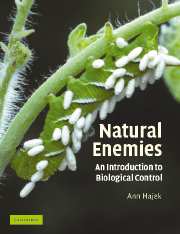Book contents
- Frontmatter
- Contents
- Preface
- Acknowledgments
- Introduction
- Chapter 1 Why use natural enemies?
- Chapter 2 Introduction to biological control
- PART I Strategies for using natural enemies
- PART II Biological control of invertebrate and vertebrate pests
- PART III Biological control of weeds
- PART IV Biological control of plant pathogens and plant parasitic nematodes
- PART V Biological control: concerns, changes, and challenges
- Glossary
- References
- Index
Chapter 2 - Introduction to biological control
Published online by Cambridge University Press: 05 June 2012
- Frontmatter
- Contents
- Preface
- Acknowledgments
- Introduction
- Chapter 1 Why use natural enemies?
- Chapter 2 Introduction to biological control
- PART I Strategies for using natural enemies
- PART II Biological control of invertebrate and vertebrate pests
- PART III Biological control of weeds
- PART IV Biological control of plant pathogens and plant parasitic nematodes
- PART V Biological control: concerns, changes, and challenges
- Glossary
- References
- Index
Summary
The amount of food for each species of course gives the extreme limit to which each can increase; but very frequently it is not the obtaining food, but the serving as prey to other animals, which determines the average numbers of a species.
(Darwin, 1859)Defining biological control
Populations of all living organisms are, to some degree, reduced by the natural actions of their predators, parasites, antagonists, and diseases. This process has been referred to as “natural control,” but when pests are controlled, this is often called biological control (sometimes shortened to biocontrol) and the agents that exert the control are frequently called natural enemies. Humans can exploit biological control in various ways to suppress pest populations. The varied approaches for manipulating the activity of natural enemies to control pests differ in how much effort is required, who is involved, and the suitability of the approach for commercial development.
Biological control has been defined many times but a commonly accepted definition is provided below.
The use of living organisms to suppress the population of a specific pest organism, making it less abundant or less damaging than it would otherwise be
(Eilenberg et al., 2001).To understand the basis for this definition, we need to discuss why biological control is used. Of course, there are a multitude of reasons. Development of biological control methods really blossomed after synthetic chemical pesticide application became the dominant method of pest control.
- Type
- Chapter
- Information
- Natural EnemiesAn Introduction to Biological Control, pp. 19 - 36Publisher: Cambridge University PressPrint publication year: 2004
- 1
- Cited by



